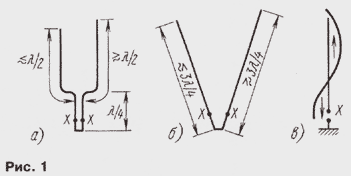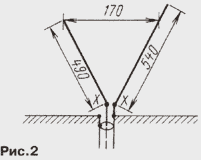New solutions are not often appear in antenna technology. To them, without a doubt, proposed last year by Vladimir Polyakov an interesting variant of two-element directional antenna with vertical the polarization. In this article he talks about possible modifications.
Description of the antenna, which is formed by two closely spaced vertical vibrators with a length of about half, which is equipped with the lower ends of the through quarter-wave two-wire line, was published in the "LW magazine" (V. Of poles. Vertical directional antenna. - "LW journal", 1998, No. 5, pp. 27- 31). She is schematically shown in Fig.1,and (XX - point connection of the feeder). In those experiments it was noticed that the shape of the "shoulders" of the antenna, as well as their the location is not that severe. Significantly more impact full length each of the vibrator, which should be slightly less than PLN/4 for one of them "Director", and slightly larger size for another "reflector". This difference in lengths of vibrators necessary for proper phasing of the currents in them and create unidirectional radiation.

And why not make vibrators straight and diverging from the base under a slight angle to the vertical, as shown in Fig. 1 ,b? After all, between their centers gravity", where the antinodes of the current will still be a distance of about L/8, and is required for normal operation of the antenna. With regard to a quarter-wave line, it will have a variable length characteristic impedance that again not scary. The divergent radiation of a quarter-wave line conductors not must be large because they are close, and the currents in them, in according to the principle of operation of the antenna, almost anti-phase (Fig.1,in).
Experimental studies of the antenna fully confirmed the expected the results of the antenna shows good focus and proved to be simple in customizing. There were some problems with it power. First antenna, like the previous one, ate "on science" - in points XX, not far distant from the short-circuited end of a quarter wave line. The center conductor of the cable they joined the principal and the braid to the reflector. Further, the cable was laid along the reflector and from the short-circuited end of the quarter-wave line (point C zero potential) went straight down. To move the point of supply at tuning an antenna in a non-parallel to the vibrators were uncomfortable. In addition, to change simultaneously the length of the vibrators and the provision of power points seemed complex.
Nevertheless antenna earned, giving directed towards short vibrator radiation with a win in 4 dB compared to half-wave dipole. Then the antenna was mounted on a "grounded" basis (metal plane, imitating the roof of the car) and move the point of powering got uncomfortable. Then it was decided that the center conductor of the cable to attach to bottom active vibrator "Director", and the braid of the cable and to connect with reflector base. Considerations were as follows: the input impedance of the active vibrator length 3L/4 is about 50 Ohms, instead of 37 Ohms for a quarter-wave, and should to ensure good coordination. If the reflector is now passive? I would say no, because it is resonant and connected directly to the braided cable,so should effectively "suck" talk from her.
All these arguments are borne out in practice and the efficiency of the antenna is increased approximately 0.5 dB. In experiments proved to be very convenient factory TV antenna - "whiskers" with two telescopic elements, band the cable which was replaced by a coaxial.
The design of the antenna, the size of which is matched to the frequency of 430 MHz (Fig. 2), exactly corresponds with the letter V. It would be called a V-antenna, but it the name has long been fixed for horizontal wire antenna. Also known is "Inverted V" antenna. By analogy, I propose to call design ""Vertical " V" antenna or VV.

It is easy to configure. Fig.2 Need only changing the length of the dipoles and tilting them, to achieve high radiation in the main direction. The signal was recorded the simplest indicator field, located a few meters from the antenna.
The gain of the antenna is estimated at 4.5 dB relative to a half-wave vibrator (about 6.5 dB relative to an isotropic radiator). The radiation pattern in the horizontal plane (azimuth), taken at points through 45°, shown in Fig. 3.

Some uneven radiation sideways due to the influence of others objects ("clean" antenna range for these measurements, the author was not). The ratio of the radiation forward/backward was not too high, about 12 dB. It can be improved, stronger pulling the reflector, but at the cost of some reduction in the gain in the gain.
Author: Vladimir Polyakov (RA3AAE)






